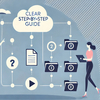
Many working environments demand collaborative writing and editing of documents. Nowadays, such collaborations are simplified. The participants don’t need to be co-located and work from the same office; they are free to reside in different geographic locations. In addition, documents are quickly and efficiently distributed through emails, phones, and chat or conferencing tools that let people gather without having to attend the office together.
Today we’ll consider two approaches to content creation: collaborative authoring and topic-based authoring, and see their strategies.
What Is Collaborative Authoring?
Collaborative authoring is a method of creating content with the help of several authors. With such a flexible process, the content can be created more quickly and with better quality. It involves using a web-based tool to create a document so that multiple members of a group can edit the document.
Collaborative Authoring Approaches
When you have several authors, you can apply several strategies, like:
- Parallel. Each author is in charge of certain parts of the content and creates their portion simultaneously with the others. After all parts are done, the content is united to create the complete document.
- Responsive. Each author is in charge of certain parts of the content. As they create their content, they modify the content taking into account what was created by other authors.
- Sequential. Each author is in charge of certain parts of the content and creates their portion after the previous author has completed theirs.
As you may see, an individual author works on their portion of content in each of these approaches. With such working practice, each author can become a bottleneck and be a point of failure for the process. For example, one author can miss the deadline with the content handover, and others won’t be able to proceed with their part. To avoid that situation, you can apply a mixed approach where authors can work on any part of the document in parallel to other authors and provide a flexible process.
Collaborative Authoring Pros and Cons
The apparent advantages of collaborative writing are:
- Content quality. When you have a team of writers, the skillset available to contribute to the content production broadens. Multiple authors can assess each other’s work and improve its quality.
- Adaptability. The documentation creation process often demands a lot of resources. With collaborative authoring, you can involve additional writers in the process to meet the increased demand. A team with a broad skill set can address a wider range of topics and tasks.
- Flexibility. Content is often just a part of a broader system, for example, product development. That’s why content production may be overlooked as a bottleneck for the system as a whole. Collaborative authoring provides flexibility to the content creation process and mitigates this risk.
- Efficient workflow. With collaborative authoring, you can create an organized workflow with other authors. Everyone will see changes right away, so it provides more transparency around what is being worked on, and no one will be doing duplicate work.
- Accessibility. All your work is stored in the cloud, so you can access it from anywhere and don’t need to worry about hard drives crashing or running out of storage. You can also log into your authoring tool from any browser, so you aren’t tied to your primary desktop computer in the office.
With the benefits of collaborative authoring, there come the following challenges:
- Consistency. Contradictory content leads to misinterpretations, and in automated environments, it can lead to production issues. And since every writer has its style, collaborative authoring teams need to control the style used to ensure that quality and consistency are maintained.
- Uniformity. All team members must understand the common goal and pull in the same direction to ensure that the final objective is achieved.
- Implementing new tools. The collective work with content demands new tools and methods for its control and ease of use.
That’s when we hit on the idea of a different approach, and the time is ripe for topic-based authoring.

What Is Topic-Based Authoring?
Topic-based authoring is an approach to producing content that is divided into small blocks of information – topics. A topic is a unit of information with a title and content, short enough to be specific to a single subject. These topics can be mixed and reused in different contexts, and the user could read them in any order and may skip around to different topics, as needed. The topic-based approach is especially suitable for technical documentation.
Topic Types
With topic-based writing, you can create three different kinds of content, each provides a different type of information for users:
- Tasks: Tell them how to accomplish their goals. It provides detailed steps to perform that task and would include pre- and post-requisites, some context about that goal or task, choices, and/or results.
- Concepts: Explain how things work or what things mean. Concepts give them a way to understand how things fit together. Concepts often include graphics that explain or illustrate, such as an architectural diagram with high-level information. (Glossary terms are a sub-type of a concept topic).
- References: Quick look up information with lots of detail. These might include very technical graphics, organized lists, and detailed tables. Reference topics are meant for scanning, not reading.
Topic-Based Authoring Pros and Cons
Technical writers are familiar with topic-based authoring. Topic-based authoring has the following advantages:
- Сoherence. Structured topics contain only the information needed to understand one concept, perform one procedure, or look up one set of reference information.
- Re-usability. Topics can be reused multiple times. This is one of the main benefits of topic-based authoring; it means you can write a topic once and then use it in many publications, such as new products, new releases, etc.
- Ease of update. It is easier to manage and translate topics, and you can reuse them in different publications.
- Сost effectiveness. It is more profitable to make updates to existing documents than create new ones.
- Speed. Updates are made faster: when you change a topic, the changes apply wherever that topic is used.
- Accessibility. Access to specific information is faster since you don’t need to go through the whole document to find the subject you need.
- Flexibility. It means that topics may be used in multiple formats across multiple outputs, such as print and online, via large desktop displays, tablets, smartphones, etc.
The question arises: If topic-based authoring is so great, why aren’t all companies implement it? Here are a few thoughts:
- Investment costs to implement changes. This is additional software that demands budgeting. Not all companies understand its benefits; therefore, they may be reluctant. All it takes is to look at ROI and consider the time it saves and the quality it increases. After that, any company will see that topic-based authoring tools are worth the efforts. People are the most expensive asset in any organization. Productivity increase is a desirable and logical thing economic-wise. For example, you have four people working with documentation, and you’re willing to hire the fifth one. Just calculate the year’s salary of that additional person and compare the number with the price of a topic-based authoring software; take ClickHelp, for instance, and you’ll see that it is less costly to buy the worthy tool.
- Changes themselves. Before switching to topic-based authoring, you must change the review process and adapt existing content to a topic-based model. Authors should vary their writing habits and start thinking structurally. Not everyone is ready to do that. It takes time and the willingness to leave the shell and start working differently. So this restriction is only in the heads and it can be mastered by training.

Conclusion
When you’re writing tech documentation and cumulating a lot of content, the topic-based authoring approach fits you best. Short topics are preferable to longer chapters or documents since they are easier to read and comprehend. This approach is implemented in ClickHelp, so the documentation is done simpler and faster with features like reusable snippets and variables for repeated pieces of content to provide users with highly focused search results. Learning to use this solution is easy. The complexity may be hidden in changing how you write or define specifications for your topics. But if applied thoroughly, topic-based authoring offers the ability to keep your content updated for almost any format. So take a close look at topic-based authoring if, for some reason, you haven’t done it yet.
Good luck with your technical writing!
ClickHelp Team
Author, host and deliver documentation across platforms and devices


